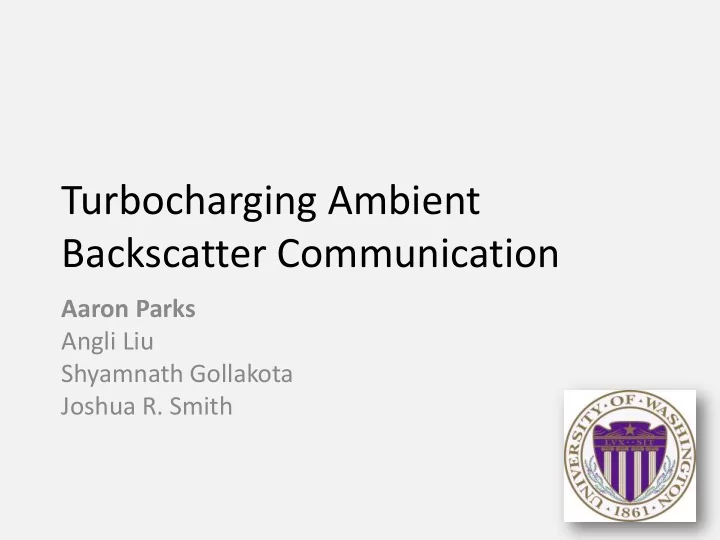

Turbocharging Ambient Backscatter Communication Aaron Parks Angli Liu Shyamnath Gollakota Joshua R. Smith 1
Radio Communication Trends Wi-Fi Bit Rates (Mbps) 1000 100 Multi- 10 Antenna 1 Then Now 1997 2002 2011 • Range (10s of km) Coding • Reliability Then Now 2
Our Work Can we achieve these techniques on battery-free devices? 3
If Possible, Benefits New Classes of Devices Wearables Localization Severe power constraints RFID Ambient Backscatter 4
Challenge: Expensive Digital Computation Coding Multiple (e.g., CDMA) antennas • Expensive correlation • Channel estimation • Synchronization, etc. • Matrix inversion, etc. Battery-free devices have orders of magnitude less power Requires power- 100’s of mW intensive ADCs
Our Design Principle Perform computation in the analog domain
Contributions • Introduce the first multi-antenna cancellation design for battery-free backscatter devices 10 kbps 1 Mbps • Introduce first analog coding technique for long-range backscatter communication 2 feet 20 meters
Ambient Backscatter Communication Limited to 10 kbps and 2 feet of range Modulated reflection Ambient Backscatter TX Ambient Backscatter RX No additional power No additional spectrum 8
Contributions • Introduce the first multi-antenna cancellation design for battery-free backscatter devices 10 kbps 1 Mbps • Introduce first analog coding technique for long-range ambient backscatter communication 2 feet 20 meters
Multi-Antennas Without Digital Computation h rf1 1 s(t) h b1 h rf2 + h b1 s(t) b(t) h rf1 s(t) 1 = Bob (RX) 2 + h b2 s(t) b(t) h rf2 s(t) 2 = h b2 b(t) Alice (TX) 10
Multi-Antennas Without Digital Computation h rf1 1 s(t) h b1 b =0 b =1 h rf2 s(t)[h rf1 + h b1 b(t) ] = Bob 1 = h rf1 , h rf1 + h b1 (RX) 2 s(t)[h rf2 + h b2 b(t) ] = 2 h rf2 h rf2 + h b2 h b2 b(t) Alice (TX) 1 Decode b(t) using changes in 2 11
Division in the Analog Domain • Commercial analog dividers are power hungry! – Build our own. 1 = exp(log( ) – log( )) 1 2 2 Log Amplifier Exp. Subtractor Thresholding Amplifier Log Amplifier Multi-antenna design without digital computation 12
Contributions • Introduce the first multi-antenna cancellation design for battery-free backscatter devices 10 kbps 1 Mbps • Introduce first analog coding technique for long-range ambient backscatter communication 2 feet 20 meters
How do we Increase Range? • Add redundancy to data for easier decoding Pattern for ‘1’ bit Pattern for ‘0’ bit RX Pattern detected here ‘1’ Cross-correlating is too expensive 14
How do we Increase Range? • Use periodic code Pattern for ‘1’ bit Pattern for ‘0’ bit 000000… Receiver simply correlates with: Gives I component No shift ½ symbol delay Gives Q component | I | + | Q | = N No synchronization required 15
How do we Increase Range? • Analog implementation Correlator I Thresholding Sum Circuit Correlator Q Simple analog implementation Low Power 16
Our Hardware Prototype • Integrated multi-antenna and coding implementation – 422 uW for multi-antenna – 8.9 uW for coding circuit • Software-defined behavior – 0.3 bps to 1 Mbps • TV , RFID, and solar harvesting 17
What Gains Can Multiple Antennas Provide? 1.E+00 10kbps, SIGCOMM ‘13 1.E-01 100x improvement BER 1.E-02 Multi-antenna, 1 Mbps 1.E-03 1.E-04 1 2 3 4 5 6 7 Distance from Scatterer to Receiver (ft) Incident TV power is -20dBm 18
What Gains Can Multiple Antennas Provide? • How do we get orders of magnitude gains by adding an antenna? • Last year (SIGCOMM ’ 13) – Average to eliminate big TV signal • Multi-antenna design – Completely cancel TV signal Orders of magnitude increase in rate 19
Can our Analog Code Increase the Range? Transmitter and receiver in line-of-sight 120 100 Range (ft) 80 Analog Coding 60 40 20 SIGCOMM ‘13 0 -30 -25 -20 -15 -10 -5 0 TV Signal Strength at Scatterer (dBm) 10-100x improvement across all power levels 20
Can our Analog Code Increase the Range? Transmitter and receiver in non-line-of-sight 4 3 3 Number of Walls 2 2 2 1 1 1 0 0 -30 -24 -18 -12 -6 0 TX TV Signal Strength at Scatterer (dBm) 21
Conclusions • Introduce the first multi-antenna and coding designs for battery-free backscatter devices • Provide orders of magnitude increase in rate and range of ambient backscatter • Re-design networking primitives with power as a first class citizen Full- duplex (MOBICOM’14), UWB (?), Random - access (?), TCP/IP (?), …
Recommend
More recommend